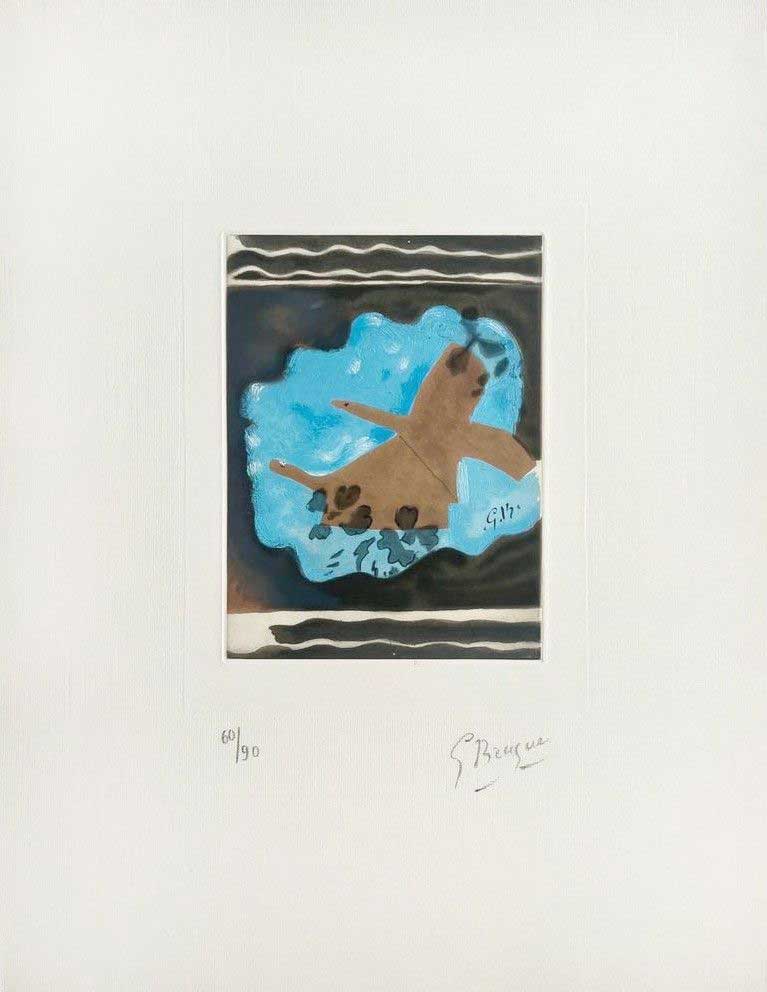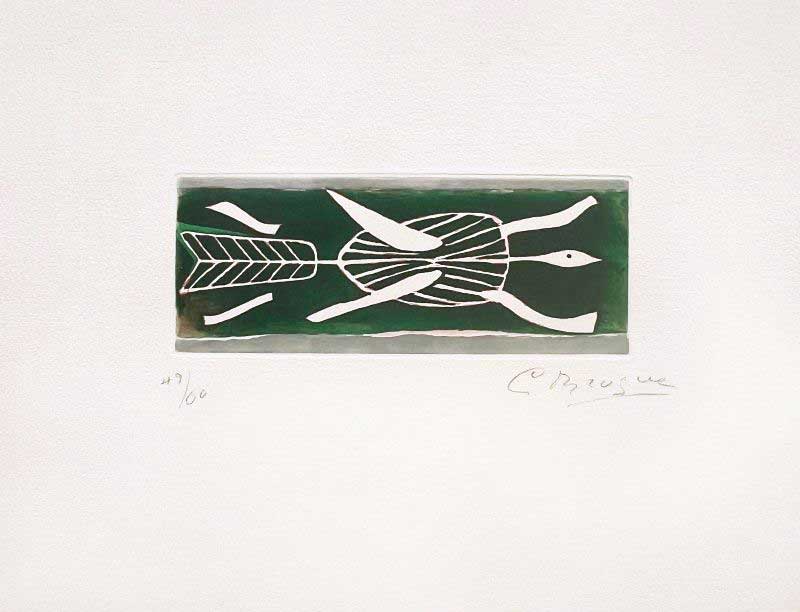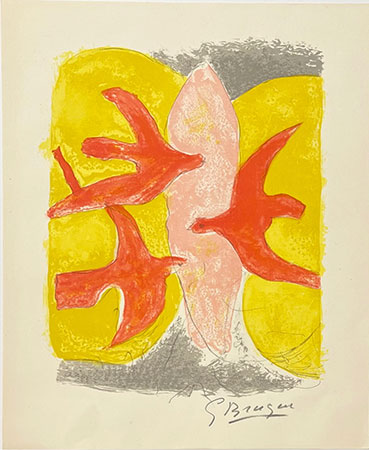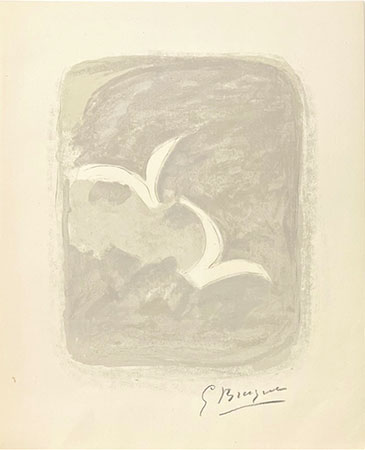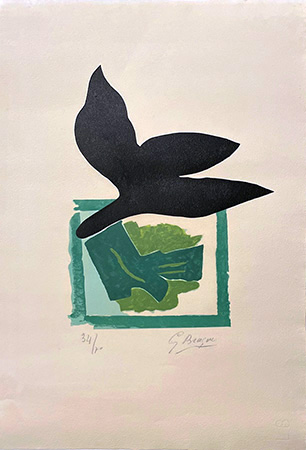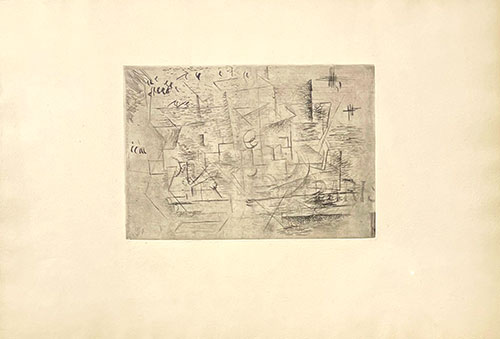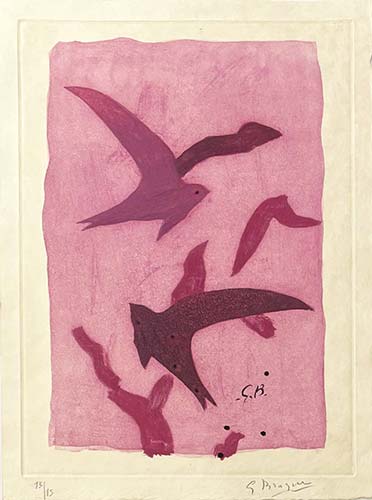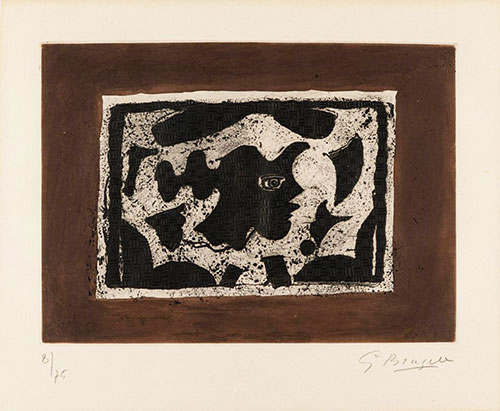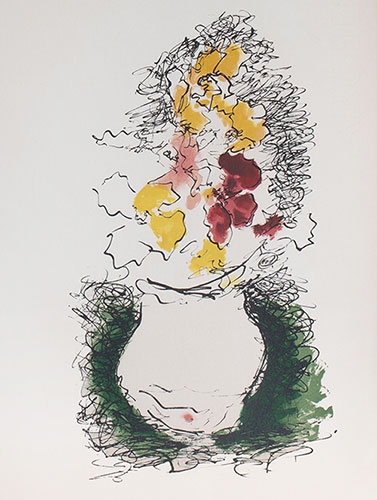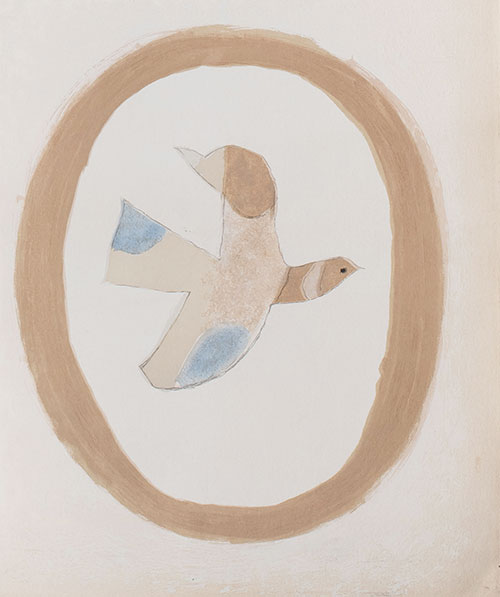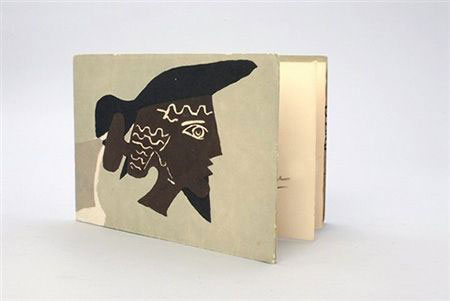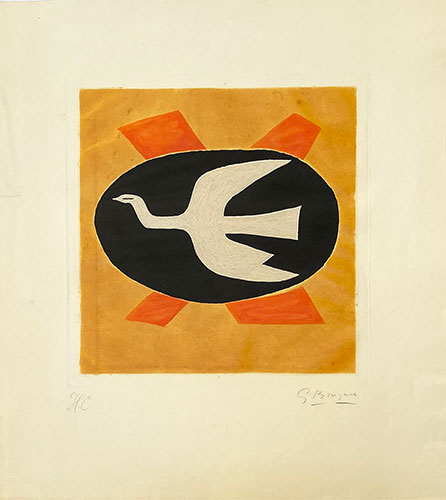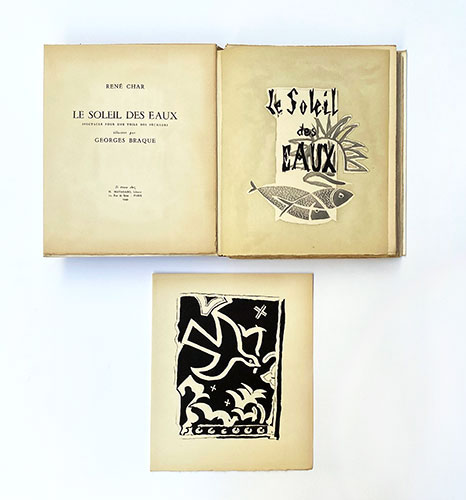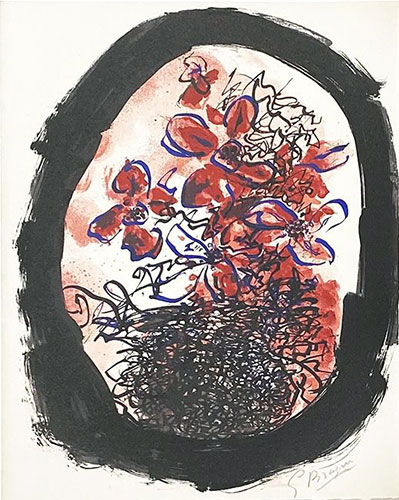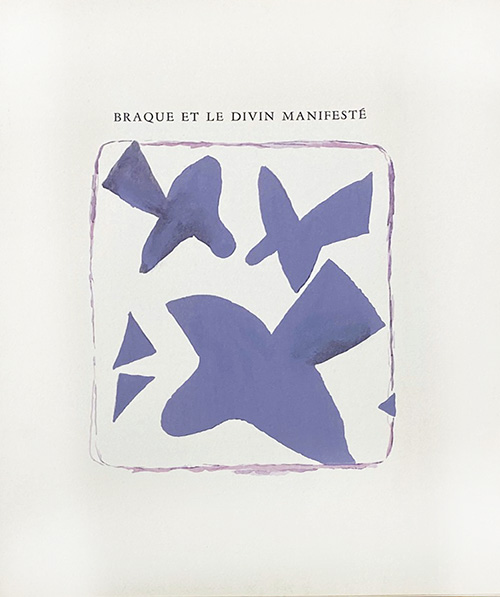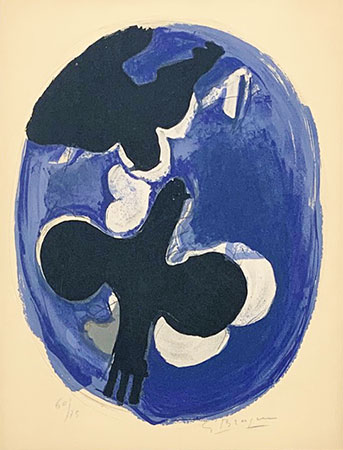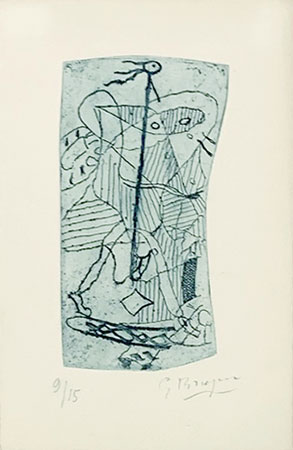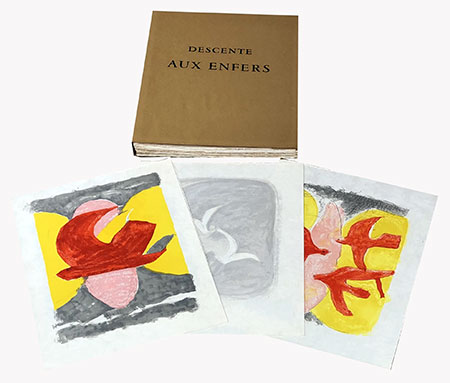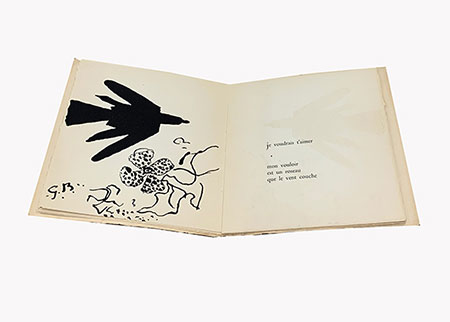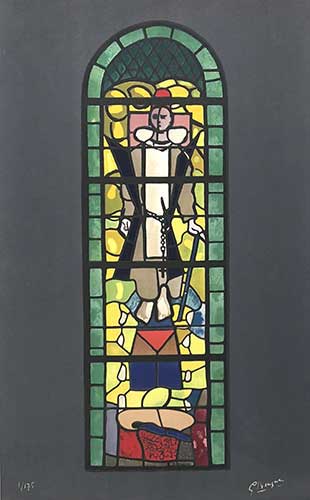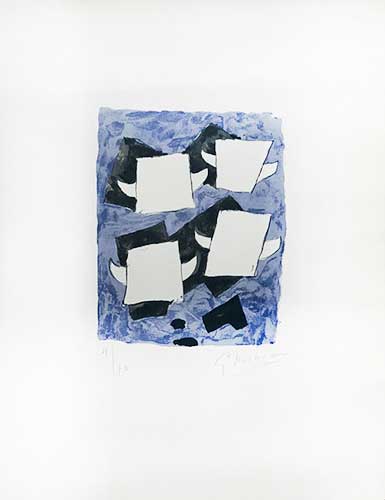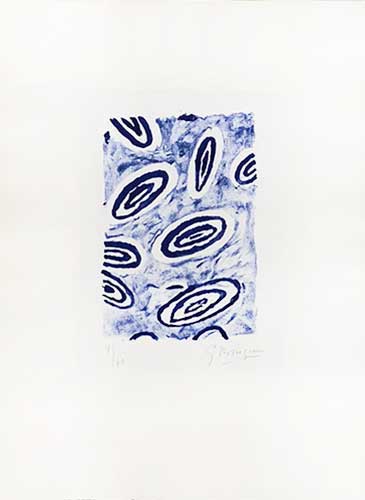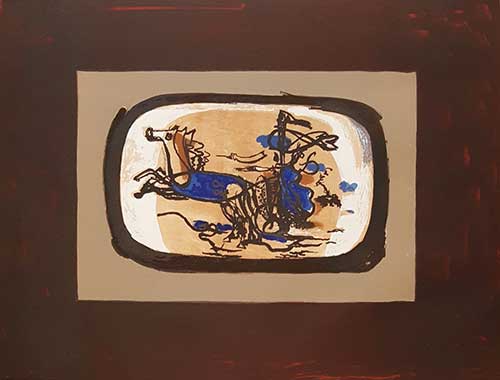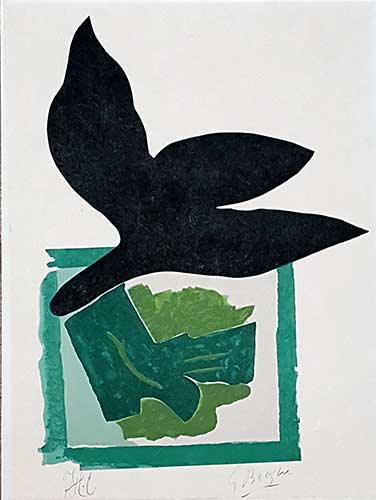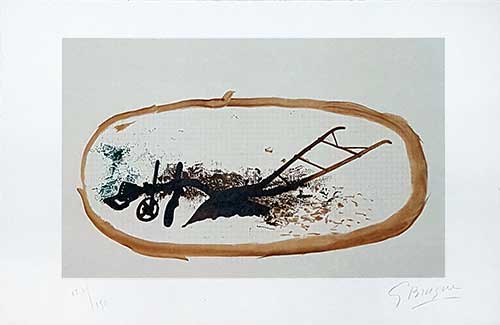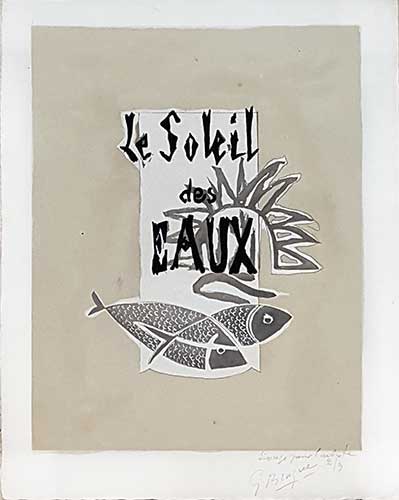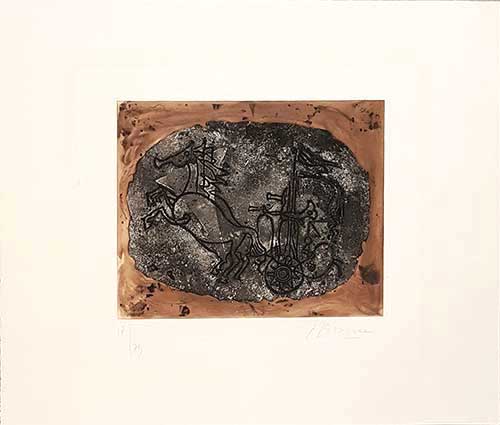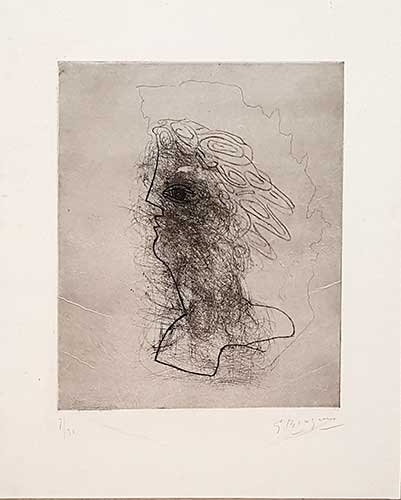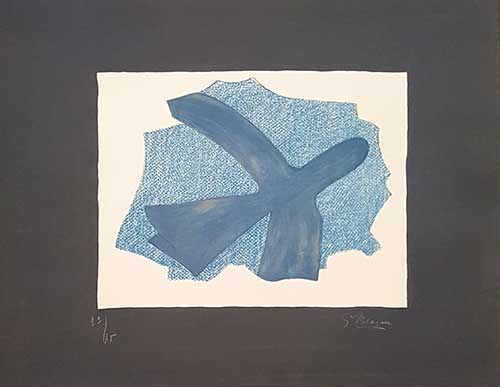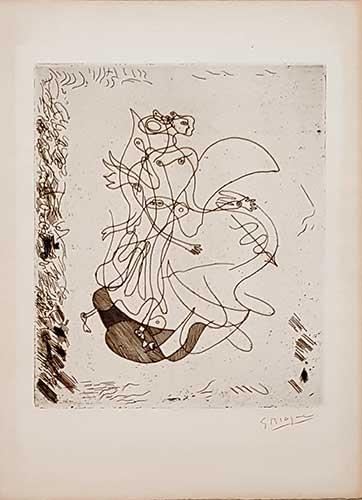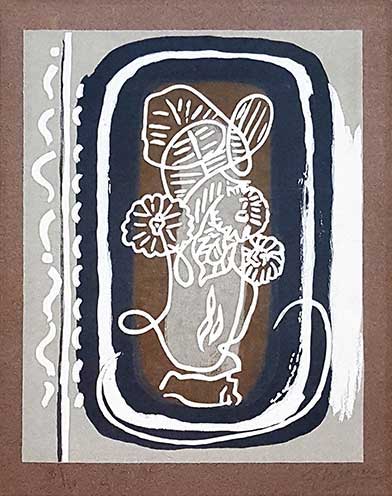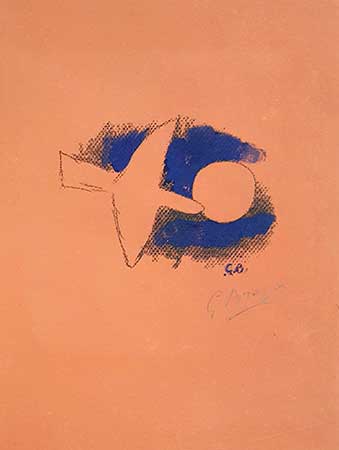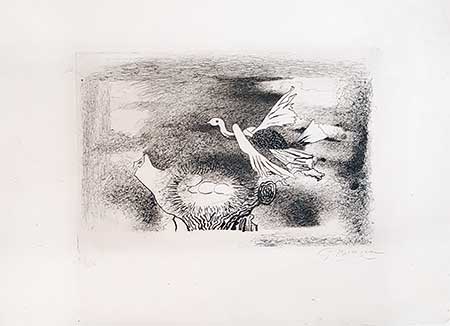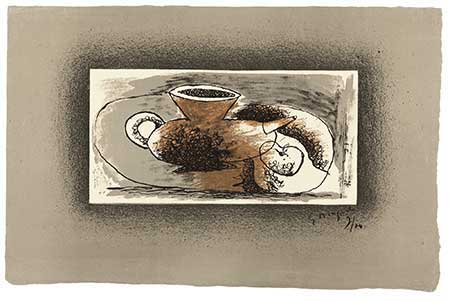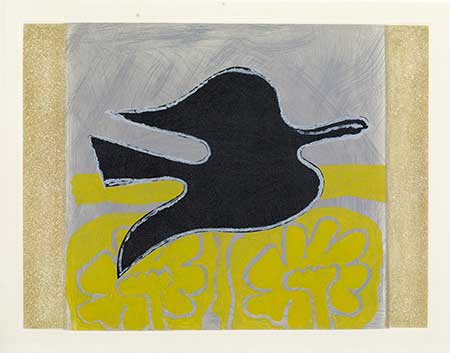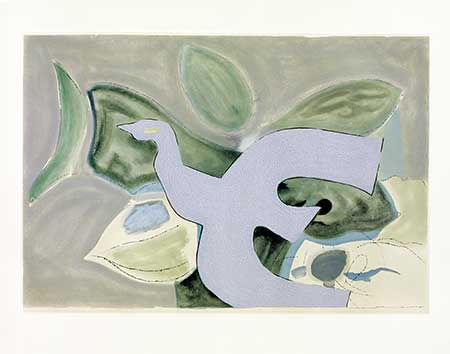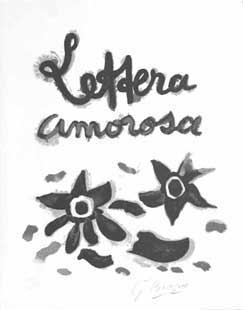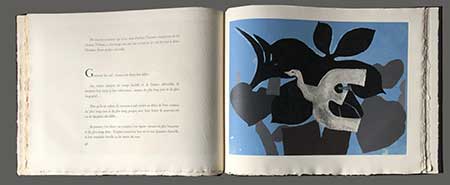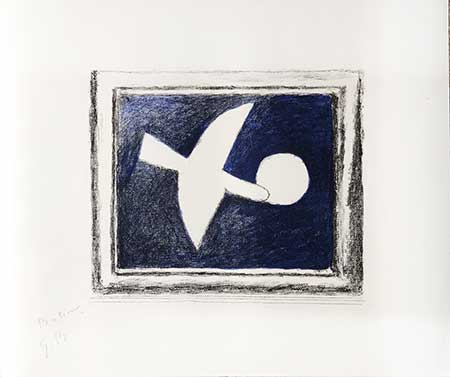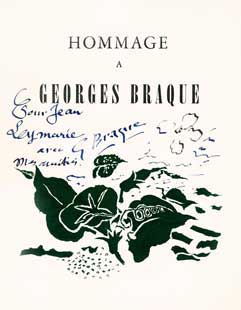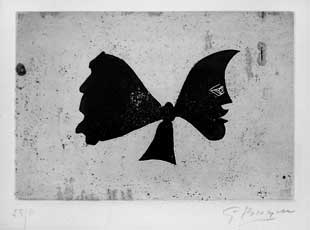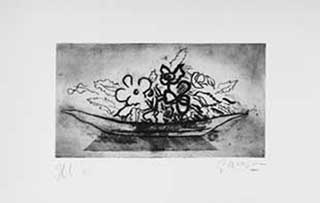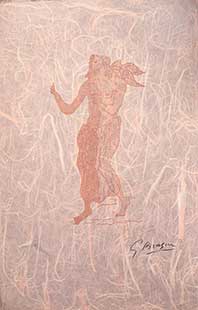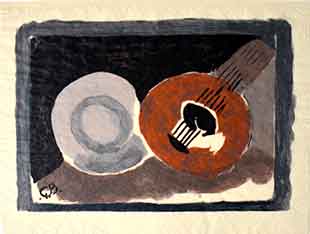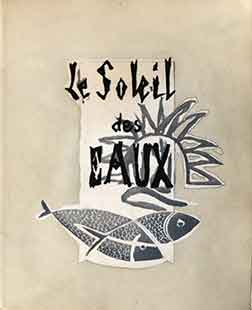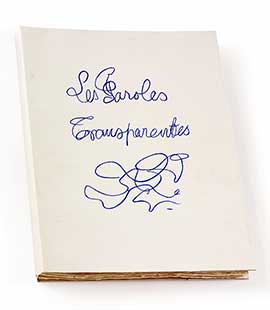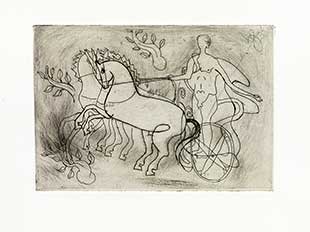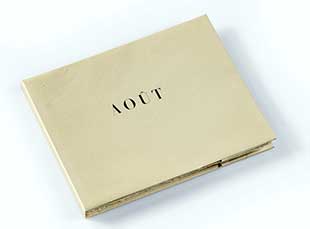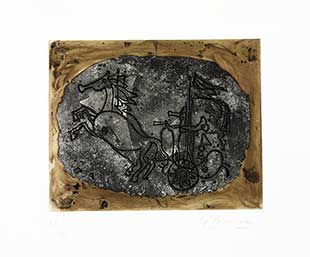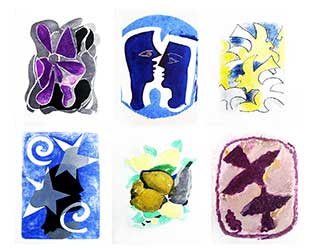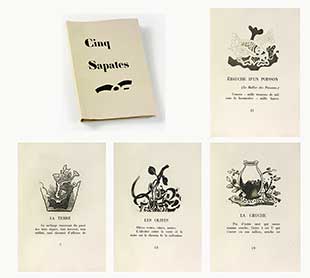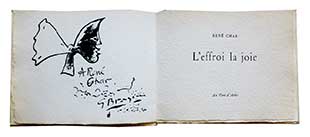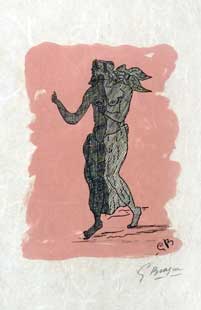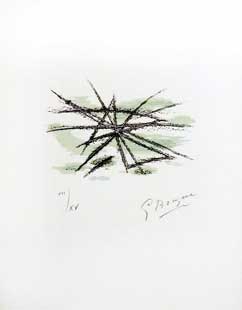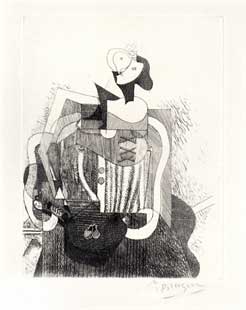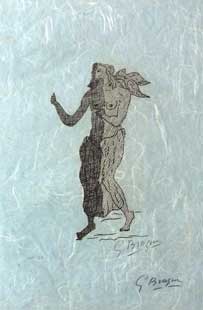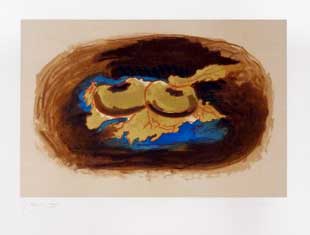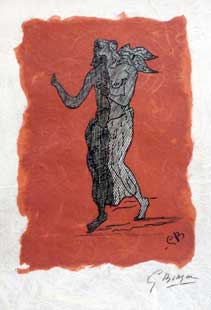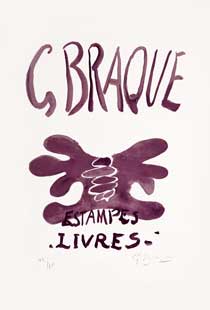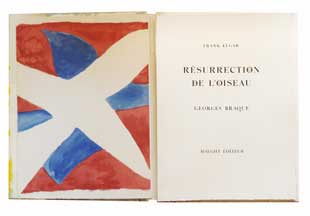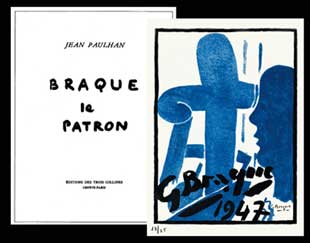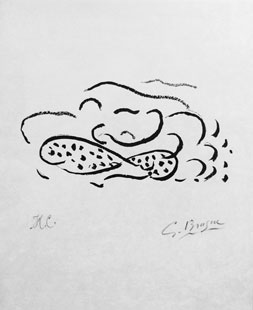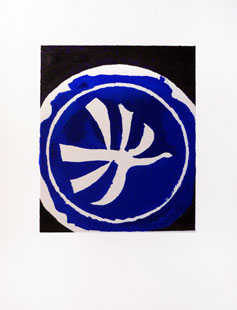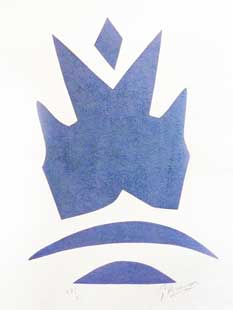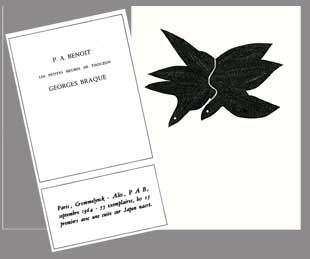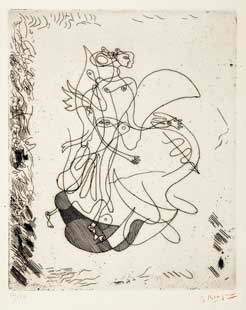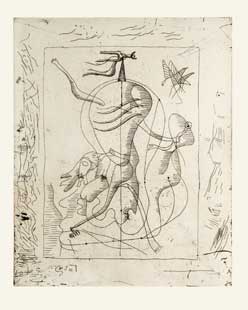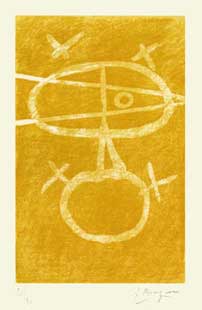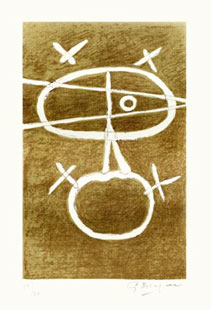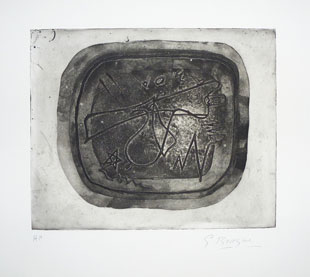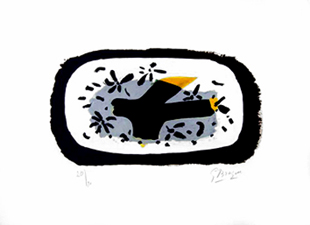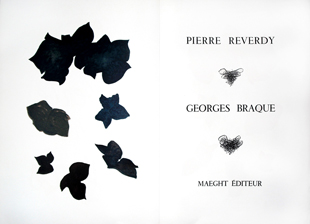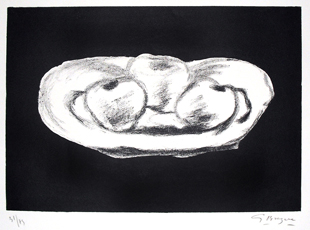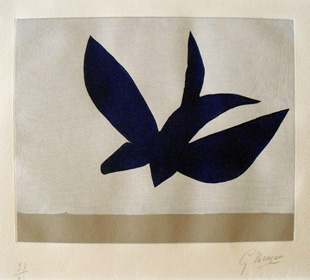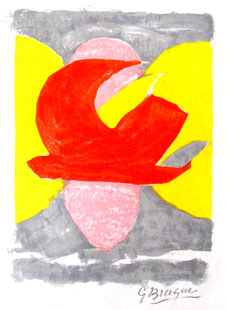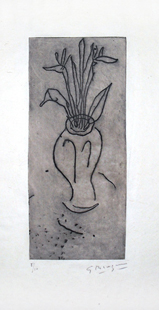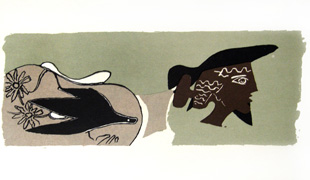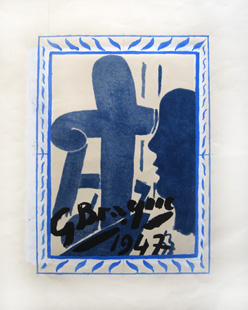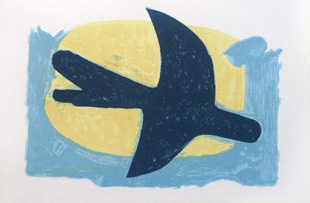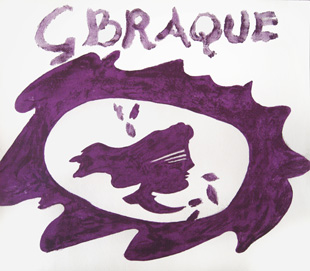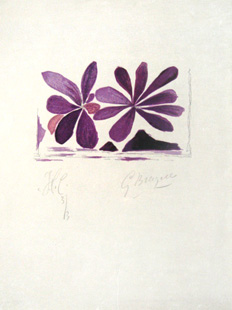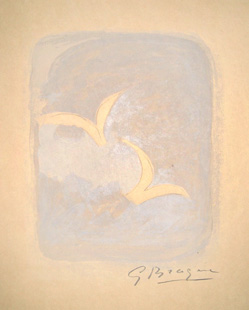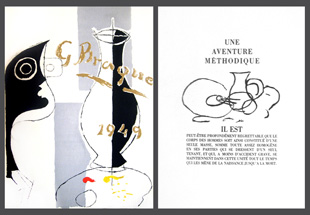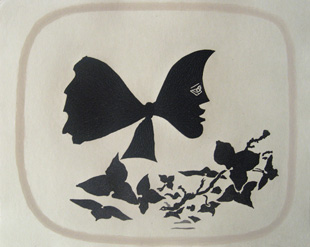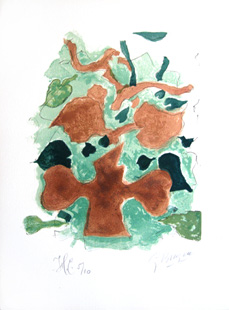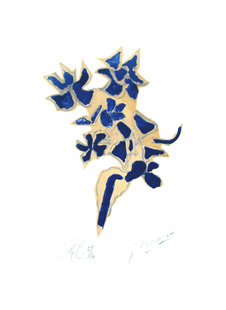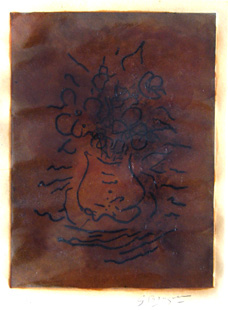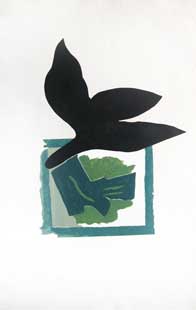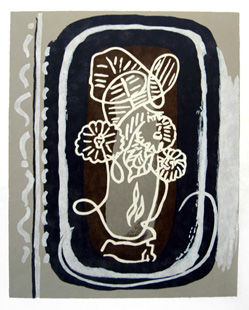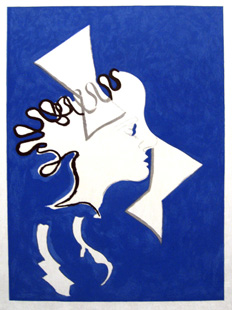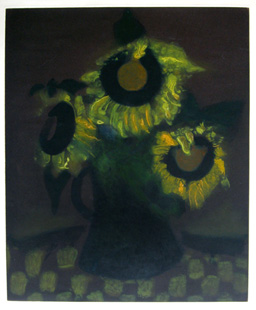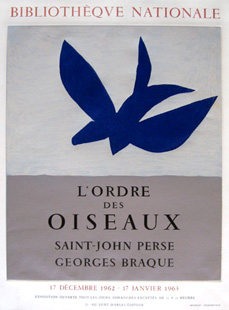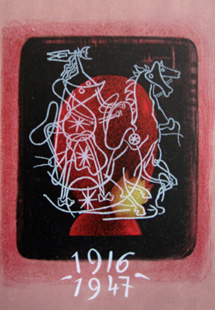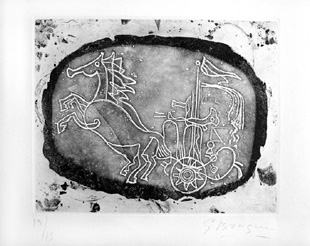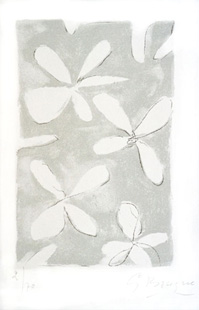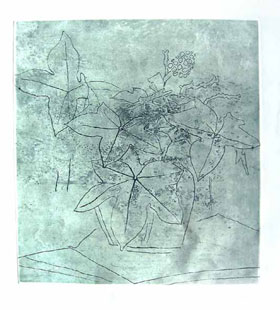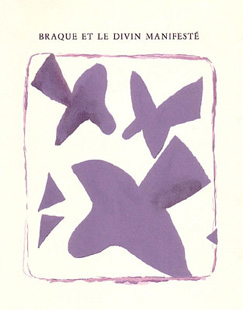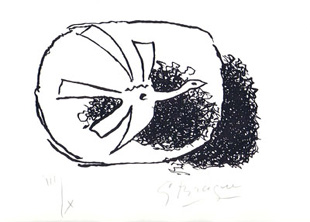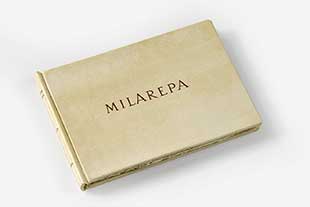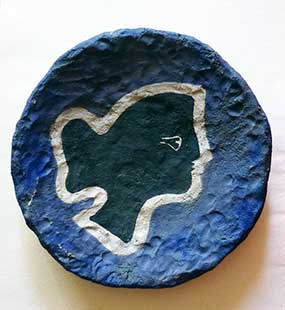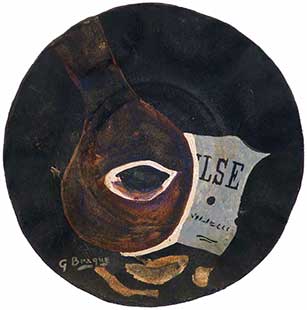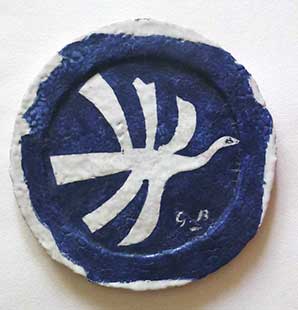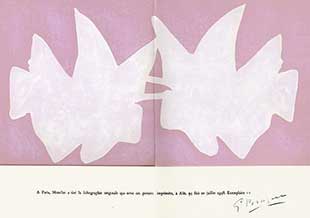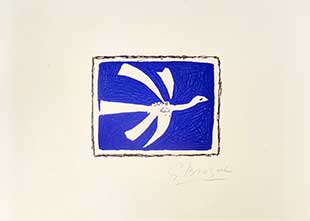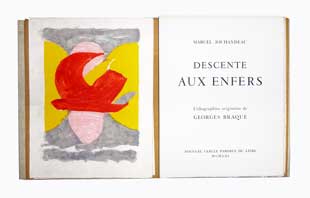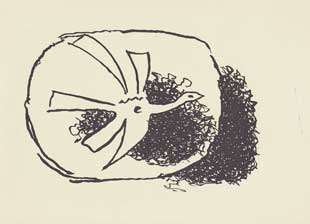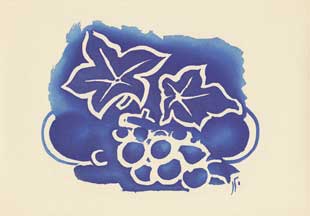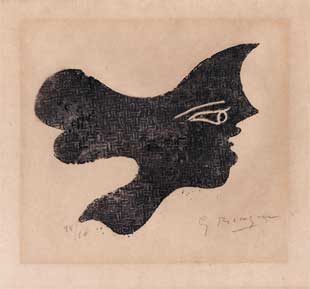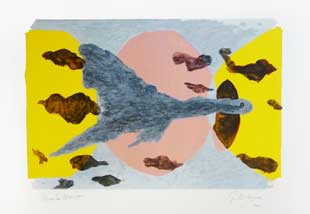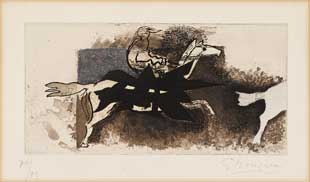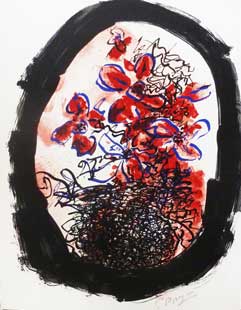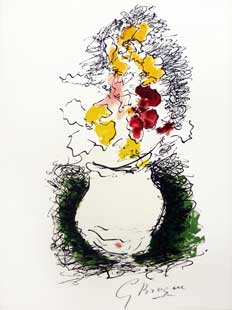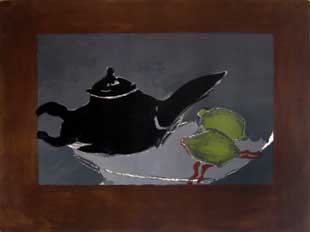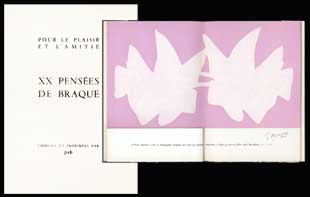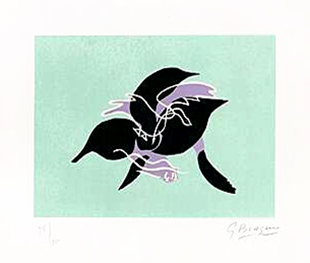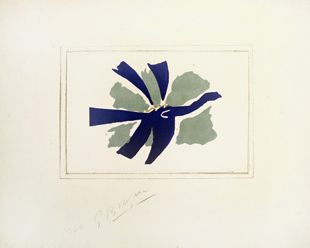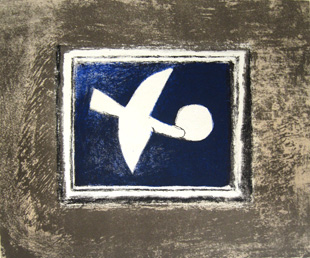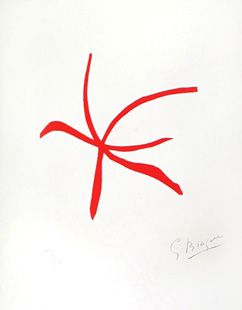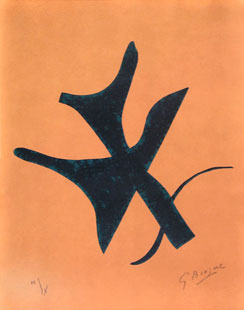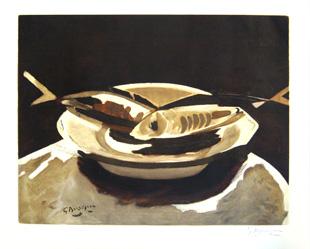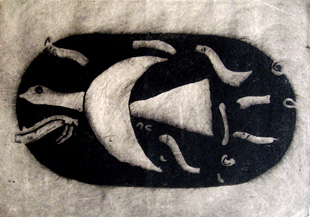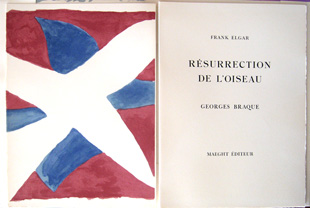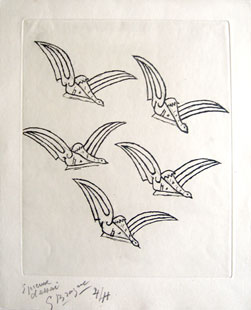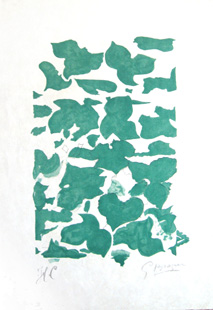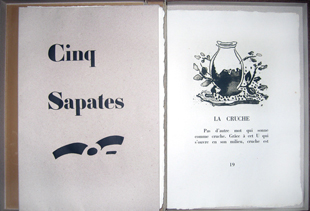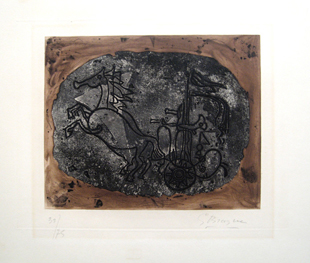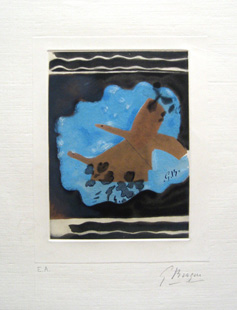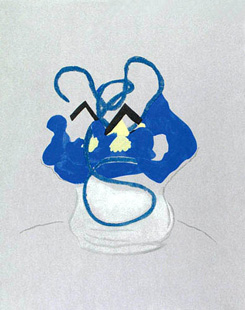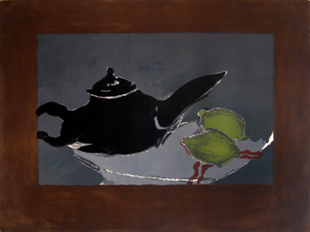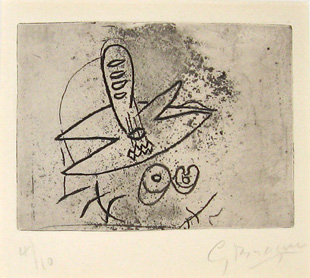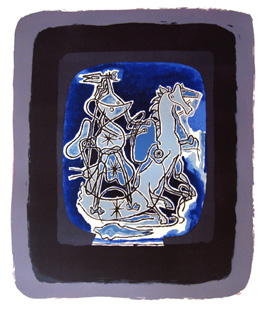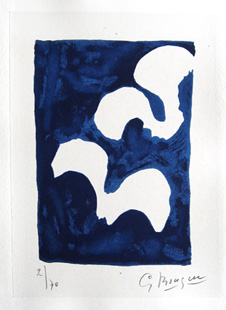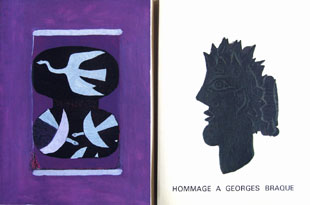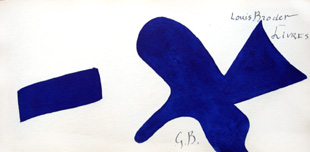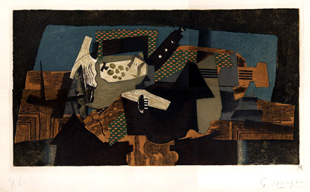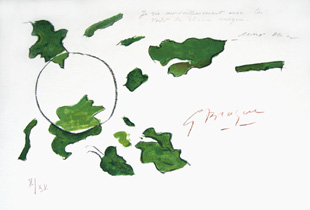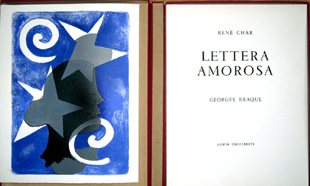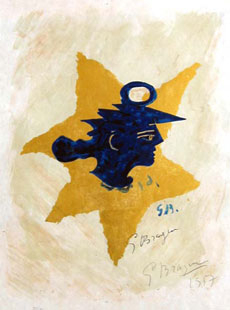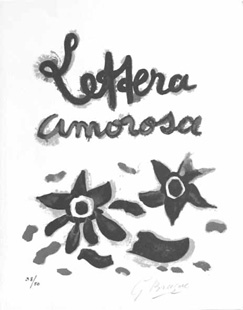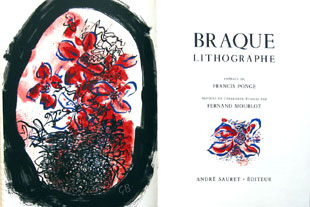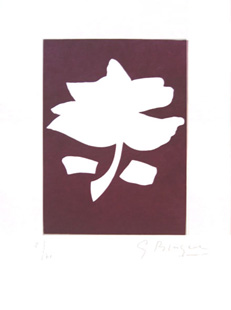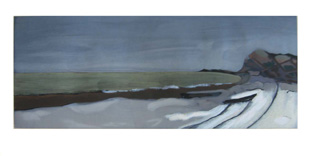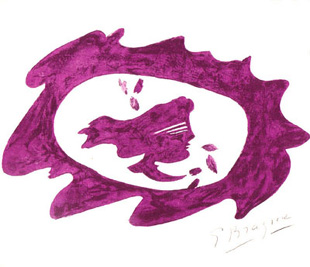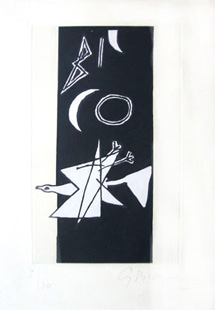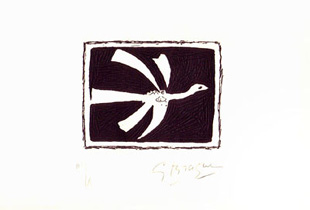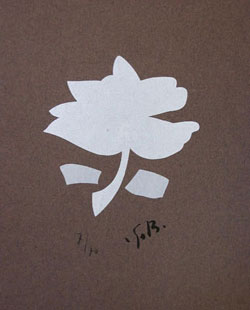BRAQUE
Prints | Biography | Catalogue raisonne | Verbatim | Prints sold | Bibliography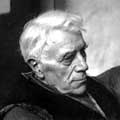 GEORGES BRAQUE
GEORGES BRAQUEHere are the prints handsigned (lithographs, etchings or engravings, illustrated books) by Georges Braque that are presently for sale. Click on the image to enlarge it. Unless otherwise specified all the prints shown on this page are signed by Braque and are original. Please contact the art gallery for prices.
Georges Braque was born in Argenteuil in 1892. From an early age, he attended evening classes at the Ecole des Beaux Arts in Le Havre, where he met Othon Friez and Raoul Dufy. In 1904 Braque set up his studio in Paris and three years later showed three paintings at le Salon des Indépendants.
Braque regularly went down to l'Estaque, near Marseille, to paint ; the works were shown by Kahnweiller in his gallery, the foreword to the catalogue of the exhibition being by the poet Apollinaire. Kahnweiller also arranged for Braque to meet Picasso ; the latter had just finished the Demoiselles d'Avignon painting, which made a strong impression on Braque. Braque then painted several pictures in the south of France, all of which were refused at the 1908 Salon d'Automne. The critics were unsparing about Braque, and Vauxcelles wrote in the "Gil Blas" review of the 14 th of November 1908 : "Mr Braque is a daring young man, he despises form, and reduces everything, landscapes, people, houses, to geometric diagrams, to cubes". The term was coined... Braque and Picasso friendship was strengthened, and until 1914 both artists worked in close collaboration, mutually influencing each other, and introducing into their pictures stencilled letters and numbers, imitations of wood and marble, sand and other substances, collages etc.
But in 1914, Braque was called up, and was seriously injured in the head. After a long convalescence, Braque started painting again in 1917, in a less angular and more colourful manner. From 1933 to 1938 Braque frequently returned to the still-life theme, and in 1949 finished the big "artist's studio" series, as well as designed the stage scenery for Molière 's Tartuffe at Jouvet request. In 1952, Braque was commissioned to decorate a ceiling in the Louvre ; in 1956, he made five stained-glass windows for a chapel in Varengeville, where he owned a house. Braque then began his work on the bird theme.
Georges Braque 's interest in prints dates from 1907. Between 1907 and 1912, Braque produced engravings in the cubist style, using etching and dry-point ("Etude de nu", "Petite guitare cubiste", "Fox", "Job", "Bass" ou encore "Pall"). He made his first lithograph in 1921, a still-life published by Kahnweiller ("Nature morte aux verres et fruits" printed by Charlot in Paris). Throughout his life, Braque continued to make prints, mastering the techniques of etching, lithography, aquatint, woodcut. Among the most important prints, there are "L'oiseau de feu" etching and aquatint with varnish from 1958, "Théière et citrons" lithograph from 1949, "l'oiseau et son ombre" from 1959, "Corbeille de fleurs", etchign with varnish from 1951, whose edition is only 10 copies, "L'oiseau sur fond carmin", etching from 1958 made in the Crommelynck atelier, "Le char noir", etching from 1958, "vol de nuit", lithograph from 1957, printed by Fernand Mourlot in Paris, L'oiseau d'octobre or "Feuilles, couleur lumière", lithograph from 1953, always with the collaboration of Fernand Mourlot.
Braque engraved work includes joint productions with major poets : Eric Satie ("Léger comme un oeuf", with one etching, Francis Ponge ( Cinq sapates) with five original etchings, Pierre Reverdy ( La liberté des mers, with 7 original lithographs in colors, Franck Elgar ( La résurection de l'oiseau illustrated with 4 original lithographs, Jean Paulhan ("Braque le Patron", with two lithographs), Guillaume Apollinaire ( Si je mourais là bas with 18 woodcuts), Marcel Jouhandeau ( La descente aux enfers with 4 lithographs) ; Saint-John Perse ( L'ordre des oiseaux, with twelve etchings and aquatints in colors). The most important of these productions is René Char 's Lettera amorosa ( Lettera amorosa), for which Braque made twenty-nine colour lithographs.
The artist has also print for collective books : "Un poème dans chaque livre" from Eluard, illustrated with 16 etchings by Joan Miro, Alberto Giacometti, Marc Chagall, André Masson etc. ; "Sentences sans paroles" with an engraving of Alberto Giacometti, Paroles peintes with prints of Marc Chagall, Bissière, Zadkine, Antoni Tapiès, Eduardo Chillida etc.
Braque died in 1963. In is orbituary delivered at The Louvre in September of that year, Malraux stated : "There is a part of France's honour called Braque, because a country's honour is also made of what it gives to the world."
Braque regularly went down to l'Estaque, near Marseille, to paint ; the works were shown by Kahnweiller in his gallery, the foreword to the catalogue of the exhibition being by the poet Apollinaire. Kahnweiller also arranged for Braque to meet Picasso ; the latter had just finished the Demoiselles d'Avignon painting, which made a strong impression on Braque. Braque then painted several pictures in the south of France, all of which were refused at the 1908 Salon d'Automne. The critics were unsparing about Braque, and Vauxcelles wrote in the "Gil Blas" review of the 14 th of November 1908 : "Mr Braque is a daring young man, he despises form, and reduces everything, landscapes, people, houses, to geometric diagrams, to cubes". The term was coined... Braque and Picasso friendship was strengthened, and until 1914 both artists worked in close collaboration, mutually influencing each other, and introducing into their pictures stencilled letters and numbers, imitations of wood and marble, sand and other substances, collages etc.
But in 1914, Braque was called up, and was seriously injured in the head. After a long convalescence, Braque started painting again in 1917, in a less angular and more colourful manner. From 1933 to 1938 Braque frequently returned to the still-life theme, and in 1949 finished the big "artist's studio" series, as well as designed the stage scenery for Molière 's Tartuffe at Jouvet request. In 1952, Braque was commissioned to decorate a ceiling in the Louvre ; in 1956, he made five stained-glass windows for a chapel in Varengeville, where he owned a house. Braque then began his work on the bird theme.
Georges Braque 's interest in prints dates from 1907. Between 1907 and 1912, Braque produced engravings in the cubist style, using etching and dry-point ("Etude de nu", "Petite guitare cubiste", "Fox", "Job", "Bass" ou encore "Pall"). He made his first lithograph in 1921, a still-life published by Kahnweiller ("Nature morte aux verres et fruits" printed by Charlot in Paris). Throughout his life, Braque continued to make prints, mastering the techniques of etching, lithography, aquatint, woodcut. Among the most important prints, there are "L'oiseau de feu" etching and aquatint with varnish from 1958, "Théière et citrons" lithograph from 1949, "l'oiseau et son ombre" from 1959, "Corbeille de fleurs", etchign with varnish from 1951, whose edition is only 10 copies, "L'oiseau sur fond carmin", etching from 1958 made in the Crommelynck atelier, "Le char noir", etching from 1958, "vol de nuit", lithograph from 1957, printed by Fernand Mourlot in Paris, L'oiseau d'octobre or "Feuilles, couleur lumière", lithograph from 1953, always with the collaboration of Fernand Mourlot.
Braque engraved work includes joint productions with major poets : Eric Satie ("Léger comme un oeuf", with one etching, Francis Ponge ( Cinq sapates) with five original etchings, Pierre Reverdy ( La liberté des mers, with 7 original lithographs in colors, Franck Elgar ( La résurection de l'oiseau illustrated with 4 original lithographs, Jean Paulhan ("Braque le Patron", with two lithographs), Guillaume Apollinaire ( Si je mourais là bas with 18 woodcuts), Marcel Jouhandeau ( La descente aux enfers with 4 lithographs) ; Saint-John Perse ( L'ordre des oiseaux, with twelve etchings and aquatints in colors). The most important of these productions is René Char 's Lettera amorosa ( Lettera amorosa), for which Braque made twenty-nine colour lithographs.
The artist has also print for collective books : "Un poème dans chaque livre" from Eluard, illustrated with 16 etchings by Joan Miro, Alberto Giacometti, Marc Chagall, André Masson etc. ; "Sentences sans paroles" with an engraving of Alberto Giacometti, Paroles peintes with prints of Marc Chagall, Bissière, Zadkine, Antoni Tapiès, Eduardo Chillida etc.
Braque died in 1963. In is orbituary delivered at The Louvre in September of that year, Malraux stated : "There is a part of France's honour called Braque, because a country's honour is also made of what it gives to the world."

Braque graphic works, Dora Vallier
- Braque lithographe, catalogue established by Francis Ponge and Fernand Mourlot which reproduced all the original lithographs made by Georges Braque. André Sauret publisher. Rare catalogue because the edition is only 4125 copies.
- Braque, l'oeuvre gravé by Dora Vallier (here reproduced. He check all the original prints by Braque (lithographs, engravings, etchings, woodcuts, as well as illustrated books. Flamarion Publisher, 1982.
- Braque lithographe, catalogue established by Francis Ponge and Fernand Mourlot which reproduced all the original lithographs made by Georges Braque. André Sauret publisher. Rare catalogue because the edition is only 4125 copies.
- Braque, l'oeuvre gravé by Dora Vallier (here reproduced. He check all the original prints by Braque (lithographs, engravings, etchings, woodcuts, as well as illustrated books. Flamarion Publisher, 1982.
"To define a thing is to substitute the definition for the thing itself".
Quote of Georges Braque.
Quote of Georges Braque.
- Georges Braque, la magie de l'estampe. Catalogue of an exhibition Georges Braque at the Museum of the Malmaison in Cannes in 2013 - 2014. Text by Frédéric Ballester. From the Theogonia period to Lettera Amorosa by René Char, illustrated by 27 original lithographs by Braque, the catalogue shows more than 150 original prints, lithographs, etchings and illustrated books, all coming from a famous private collection. important illustrated bibliographical information of Braque at the end of the catalogue.
- Georges Braque, Graphische Werk. Catalogue of an exhibition Braque at the gallery Boiserée in Cologne, Germany, in 2010. Probably, appart from the catalogue raisonne made by Dora Vallier, the most complet catalogue to discover the graphic work by Georges Braque. All the most important original prints by Braque are in the catalogue, such as Oiseau dans le feuillage (lithograph) or oiseau sur fond carmin (engraving), or some very rare etchings from the years 50. Text by Michael Brödje, bibliographical information and several portraits of Braque in the end of the catalogue.
- Georges Braque, His graphic works. Published by Abrams, this very nice book is also devoted to the original prints of Georges Braque. The text is written by Werner Hofmann. All the period of Georges Braque are shown from the fisrt cubist etchings to the birds of the years 60. the same publisher in the same collection, appart from Braque, published also books devoted to their prints by Chagall, Picasso and Miro.
- Georges Braque, Grand Palais. Catalogue of the exhibition Georges Braque in the Grand Palais in Paris in 2013 - 2014. More than 300 works by Braque are here chronologically reproduced. All the period of Braque are showed, cubism, papiers collés, fauvism. The close collaboration of Braque with Picasso as well as with several poets is also pushed foward. This very important exhibition Braque was after showed in the Museum of Fine Arts in Boston. Publisher Réunion des Musées Nationaux.
- Georges Braque, Graphische Werk. Catalogue of an exhibition Braque at the gallery Boiserée in Cologne, Germany, in 2010. Probably, appart from the catalogue raisonne made by Dora Vallier, the most complet catalogue to discover the graphic work by Georges Braque. All the most important original prints by Braque are in the catalogue, such as Oiseau dans le feuillage (lithograph) or oiseau sur fond carmin (engraving), or some very rare etchings from the years 50. Text by Michael Brödje, bibliographical information and several portraits of Braque in the end of the catalogue.
- Georges Braque, His graphic works. Published by Abrams, this very nice book is also devoted to the original prints of Georges Braque. The text is written by Werner Hofmann. All the period of Georges Braque are shown from the fisrt cubist etchings to the birds of the years 60. the same publisher in the same collection, appart from Braque, published also books devoted to their prints by Chagall, Picasso and Miro.
- Georges Braque, Grand Palais. Catalogue of the exhibition Georges Braque in the Grand Palais in Paris in 2013 - 2014. More than 300 works by Braque are here chronologically reproduced. All the period of Braque are showed, cubism, papiers collés, fauvism. The close collaboration of Braque with Picasso as well as with several poets is also pushed foward. This very important exhibition Braque was after showed in the Museum of Fine Arts in Boston. Publisher Réunion des Musées Nationaux.

Georges Braque, la magie de l'estampe
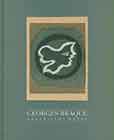
Georges Braque,Graphische werke
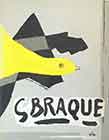
Georges Braque, His graphic works

Georges Braque, Grand Palais


